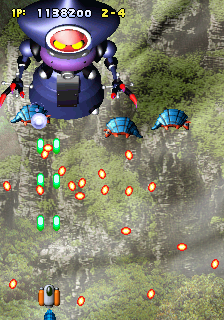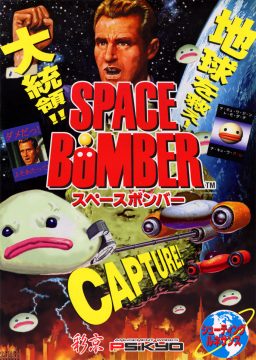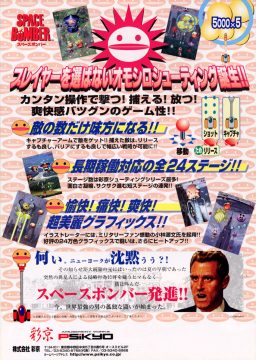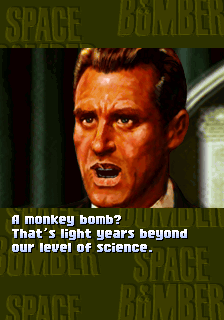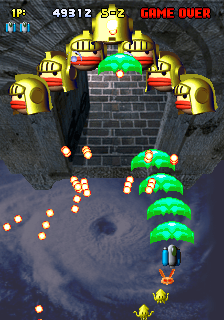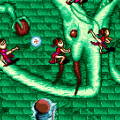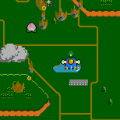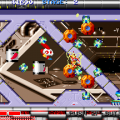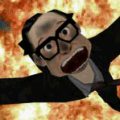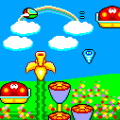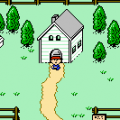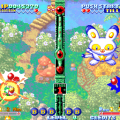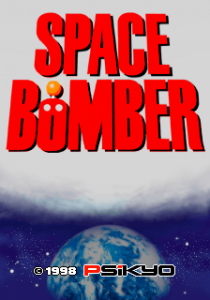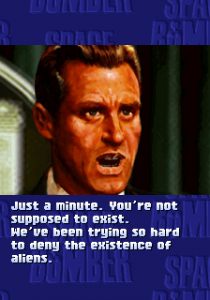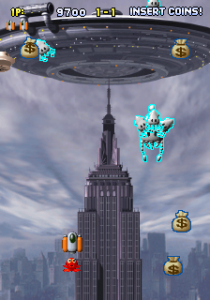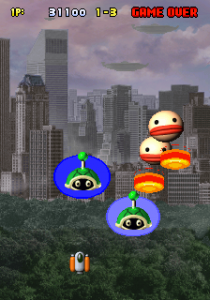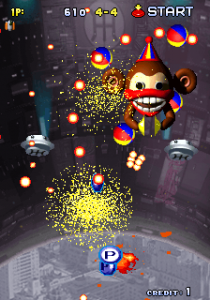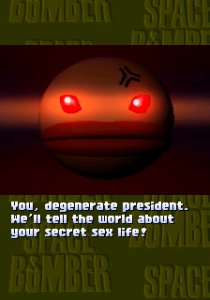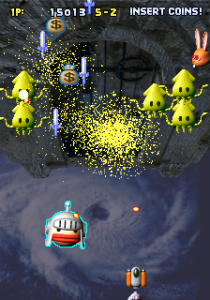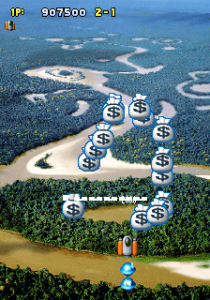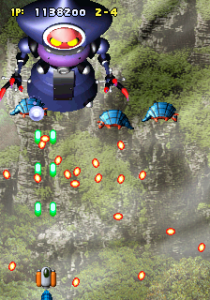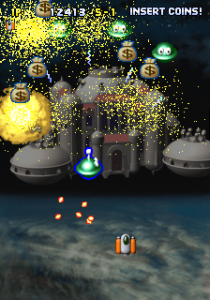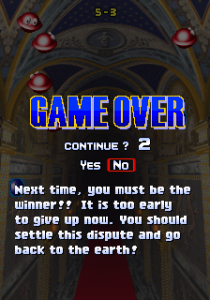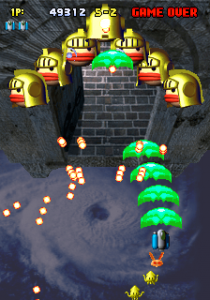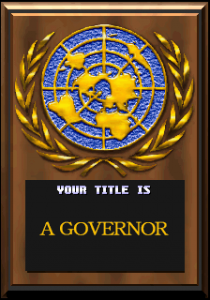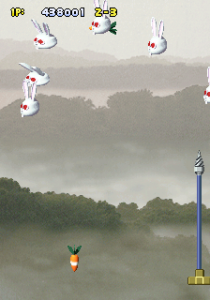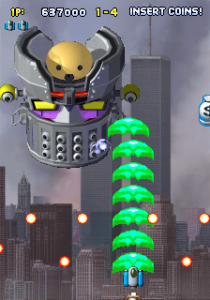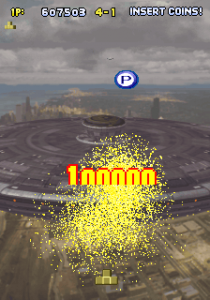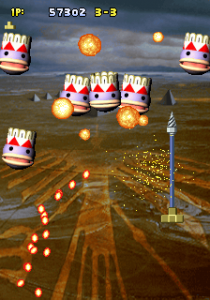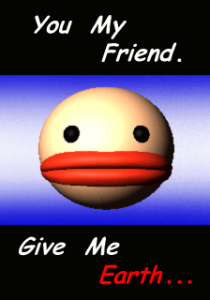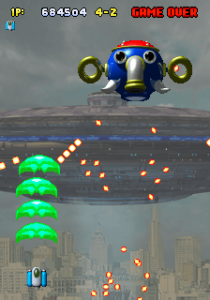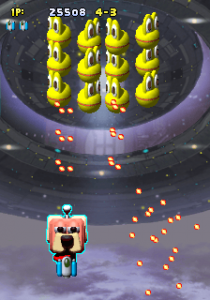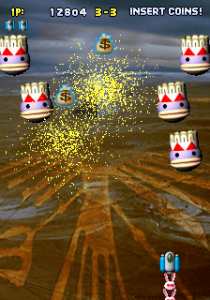Back when Psikyo was still in the business, they made a name for themselves with their Sengoku and Strikers shoot-em-up series, well-regarded but still fairly conventional games. In 1998/99 though the company released two shooters that are quite different in tone and style from all the others they’ve made: Pilot Kids and Space Bomber, a horizontal and vertical cute-em-up respectively with colorful pre-rendered graphics. Though they already did something similar, in the previous year’s Sol Divide, this time adopting that particular style is justified, because the characters and settings are meant to be “fake” and cartoonish: living dolls flying around a house and battling other toys in Pilot Kids and, as for Space Bomber… well, let’s just say it is the silliest title Psikyo has ever made.
Like many other arcade shoot-em-ups, it deals with an alien invasion, only this time it’s a Japanese take on American sci-fi B-movies, complete with cheap-looking flying saucers and cutscenes made of comic book-esque stills, featuring a hot-blooded President of the USA arguing with the alien spokesperson, who looks like a smiley face with huge lips. Everything is intentionally cheesy, like the Engrish lines in the attract mode being written in the infamous Comic Sans and Wingdings fonts, or the high score table having an image of the Statue of Liberty and stars and stripes as background. It’s not as madcap as Parodius or Space Invaders ’95, but it still has some crazy moments like the trashcan-shaped robot that turns into a Mazinger Z parody, or the neutron bomb that sheds its shell revealing one of those creepy “cymbal-banging monkey” toys inside it.
There are also several references to “actual” UFO mythology: that H-shaped symbol used as a sigil by the invaders has been lifted from tales of people who experienced first contact with aliens, and some of the sub-bosses and bosses are based on things like the Adamski spacecraft and the Flatwoods Monster, pieces of UFO lore that originated in the USA but for whatever reason have become fairly common in Japanese popular culture. The backgrounds also depict things like crop circles or “mysterious” UFO-related sites such as Stonehenge or the Nazca Lines. The space aliens mostly look like cutesy animal toys, like the type one can find inside a crane game, and in fact the whole setting appears to be based on a pun: these amusement machines are called “UFO Catcher” in Japan, and the ship controlled by the player (the titular Space Bomber) is indeed equipped with a mechanical claw that can be used to grab and capture the enemies.
The ”capture” element is central to the gameplay (even mentioned in big bright letters on the game’s flyer), which is again quite unlike the rest of Psikyo’s output: Space Bomber is a retro-style example of single-screen shooter a la Galaga, though more complex than those, where the player has to defeat incoming waves of enemies. Our ship can store up to three enemies, kept in line behind it, and they are even kept from one stage to the other. All the action is conducted with two buttons: one to shoot the laser and the other to unleash the claw that will grab every enemy or bonus in front of it. Holding the shoot button and then releasing it will deploy whatever enemy is held hostage at the moment, one at a time. The spaceship’s standard laser cannon never changes and can only be powered up a few times by catching the typical “P” icons; however, releasing a captured enemy means using its weapon against its fellow invaders, so in actuality there are as many types of weapons as there are different kinds of baddies being thrown at us.
This aspect is interesting because the invaders’ weapons change when they are in our possession. For example, rabbits drop carrot bombs on us, but when deployed shoot a few carrot missiles upwards before vanishing; frogs have a multi-way musical note spread; cats go all the way up the screen while swiping with their claws in front of them, and so on. This is important for the scoring too, because every invader defeated by a released enemy’s weapon will drop a cartoon-esque money bag, that can be picked up or grabbed with the claw for points. So it’s better to remember enemy patterns and how the various weapons work, in order to deploy them in the most effective way possible. A couple of critters (turtles and armadillos) also work as defensive barriers instead when released, which is quite useful, since the game becomes hard soon after the first two areas, and the bullet patterns sprayed by these goofy robots and animals becomes more in line with other Psikyo titles.
However, there’s an even better and quicker way in which the enemies can be used: while keeping the shoot button pressed, tapping the claw button will cause the captured enemy to be launched upwards, making them collide with the others and causing chain reactions that destroy every enemy ship caught in the resulting explosions. Wiping out entire waves or formations of baddies this way gives us big score bonuses in addition to score multipliers, but that’s not all: every invader destroyed in this way turns into an even bigger and more valuable money bag. So, there are opportunities for huge scores, provided that one can still catch that many bags at once. What seemed a very basic game can actually be approached as something of a block puzzle with bullets, though one almost wonders why even bother to release enemies and learn about their weapons at all, instead of just throwing them, especially since deployed enemies can easily be destroyed by all the bullets floating around and throwing them is faster, more damaging and gives many more points if the explosions connect.
There are even hidden secret ships that can be selected by inputting certain directions on the title screen after inserting a coin. One is just the basic ship in a different color, that has a more powerful wave gun instead of the puny laser cannon of the standard player. But the other, besides being shaped like a Tetris T-block for some reason, has a spread shot and most importantly swaps the claw with a drill weapon that destroys enemies (and power ups) instead of capturing them, thus negating the whole concept of the game. On one hand, the drill is very powerful and can make short work of mid-bosses and bosses, and can still defeat bunches of enemies at once; on the other, being unable to grab and throw enemies forces us to get closer to them (not to mention that it becomes harder to avoid the bullets without shields), and not being able to capture them at all means no more money bags. This is the weirdest thing about the game, an alternate play style that removes all of its most original features and most of the scoring opportunities.
Space Bomber is an oddball not only if compared to the rest of Psikyo’s output, but to late 90s arcade shoot-em-ups in general: quite difficult for a cute-em-up but too different from what a bullet hell game is ”supposed” to be, cutesy and goofy but too tame if compared to the zanier parody games from that time, the grab-and-throw mechanic seems more suited for a puzzle game at times, the graphics are intentionally cheap, the soundtrack is unremarkable and drowned by the cartoony sound effects… Still, it’s an interesting example of a retro-styled game made back when this kind of nostalgia for ages past wasn’t so widespread. Little bit of trivia: Space Bomber and Pilot Kids are also connected by the fact that Scitron/Gamest published an album featuring music tracks from both games, plus an arrangement of a Sengoku Ace BGM for good measure.
Links
Shmups Wiki – Description of game mechanics and how to unlock the secret ships.
VGMdb.net – Database page for the limited release soundtrack album.
Arcade History – Details of the differences between the prototype and the more common “Version B” of the game (added cutscenes, some bullet patterns made easier, graphic changes etc.)
